James Bailey
E-BATS: Efficient Backpropagation-Free Test-Time Adaptation for Speech Foundation Models
Jun 08, 2025Abstract:Speech Foundation Models encounter significant performance degradation when deployed in real-world scenarios involving acoustic domain shifts, such as background noise and speaker accents. Test-time adaptation (TTA) has recently emerged as a viable strategy to address such domain shifts at inference time without requiring access to source data or labels. However, existing TTA approaches, particularly those relying on backpropagation, are memory-intensive, limiting their applicability in speech tasks and resource-constrained settings. Although backpropagation-free methods offer improved efficiency, existing ones exhibit poor accuracy. This is because they are predominantly developed for vision tasks, which fundamentally differ from speech task formulations, noise characteristics, and model architecture, posing unique transferability challenges. In this paper, we introduce E-BATS, the first Efficient BAckpropagation-free TTA framework designed explicitly for speech foundation models. E-BATS achieves a balance between adaptation effectiveness and memory efficiency through three key components: (i) lightweight prompt adaptation for a forward-pass-based feature alignment, (ii) a multi-scale loss to capture both global (utterance-level) and local distribution shifts (token-level) and (iii) a test-time exponential moving average mechanism for stable adaptation across utterances. Experiments conducted on four noisy speech datasets spanning sixteen acoustic conditions demonstrate consistent improvements, with 4.1%-13.5% accuracy gains over backpropagation-free baselines and 2.0-6.4 times GPU memory savings compared to backpropagation-based methods. By enabling scalable and robust adaptation under acoustic variability, this work paves the way for developing more efficient adaptation approaches for practical speech processing systems in real-world environments.
X-Transfer Attacks: Towards Super Transferable Adversarial Attacks on CLIP
May 08, 2025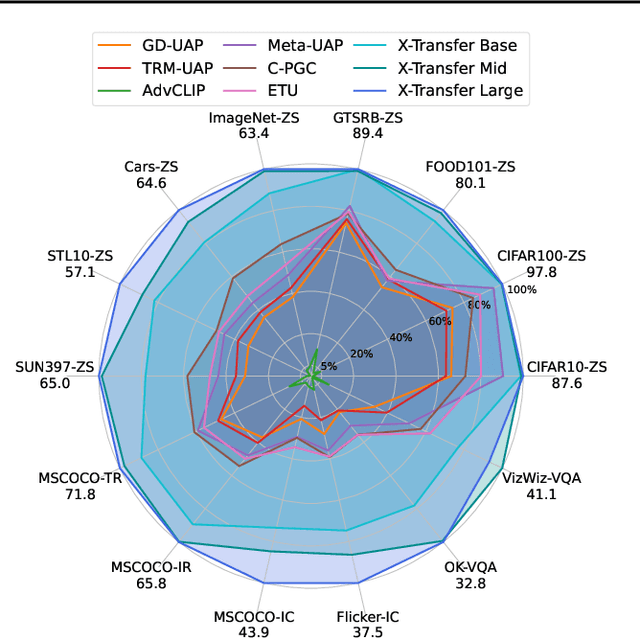
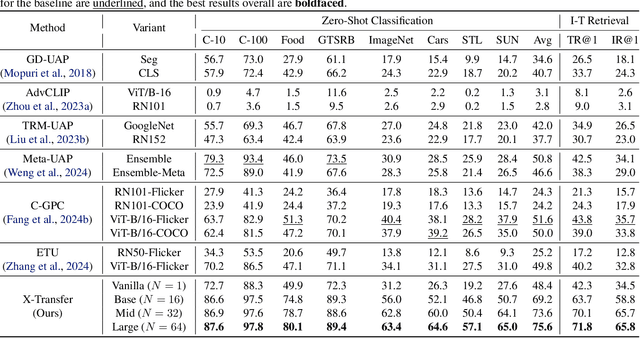
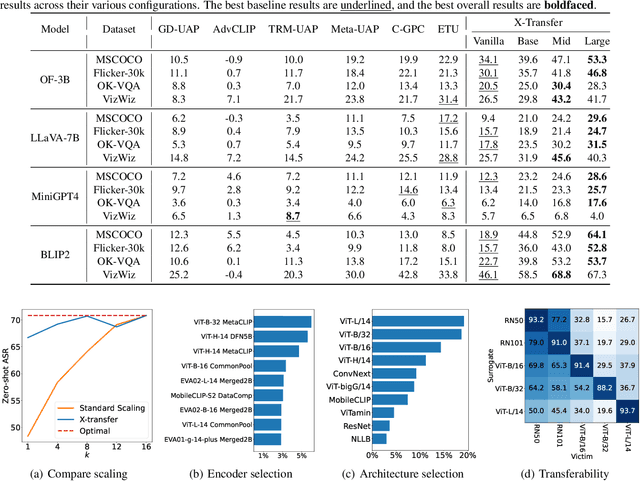

Abstract:As Contrastive Language-Image Pre-training (CLIP) models are increasingly adopted for diverse downstream tasks and integrated into large vision-language models (VLMs), their susceptibility to adversarial perturbations has emerged as a critical concern. In this work, we introduce \textbf{X-Transfer}, a novel attack method that exposes a universal adversarial vulnerability in CLIP. X-Transfer generates a Universal Adversarial Perturbation (UAP) capable of deceiving various CLIP encoders and downstream VLMs across different samples, tasks, and domains. We refer to this property as \textbf{super transferability}--a single perturbation achieving cross-data, cross-domain, cross-model, and cross-task adversarial transferability simultaneously. This is achieved through \textbf{surrogate scaling}, a key innovation of our approach. Unlike existing methods that rely on fixed surrogate models, which are computationally intensive to scale, X-Transfer employs an efficient surrogate scaling strategy that dynamically selects a small subset of suitable surrogates from a large search space. Extensive evaluations demonstrate that X-Transfer significantly outperforms previous state-of-the-art UAP methods, establishing a new benchmark for adversarial transferability across CLIP models. The code is publicly available in our \href{https://github.com/HanxunH/XTransferBench}{GitHub repository}.
Parsimonious Dataset Construction for Laparoscopic Cholecystectomy Structure Segmentation
Apr 17, 2025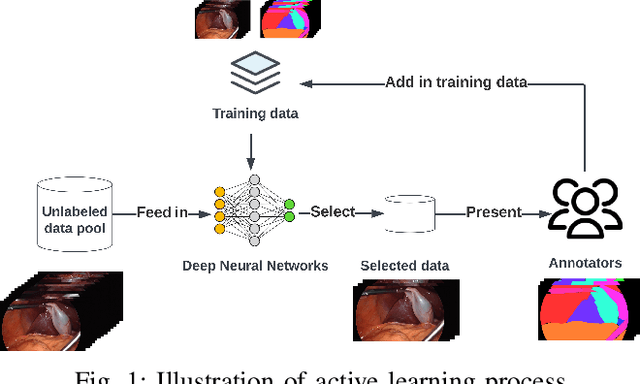
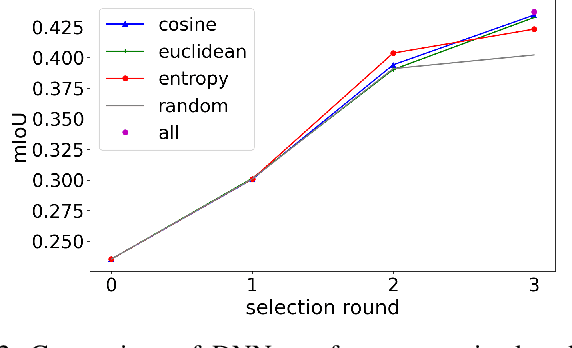
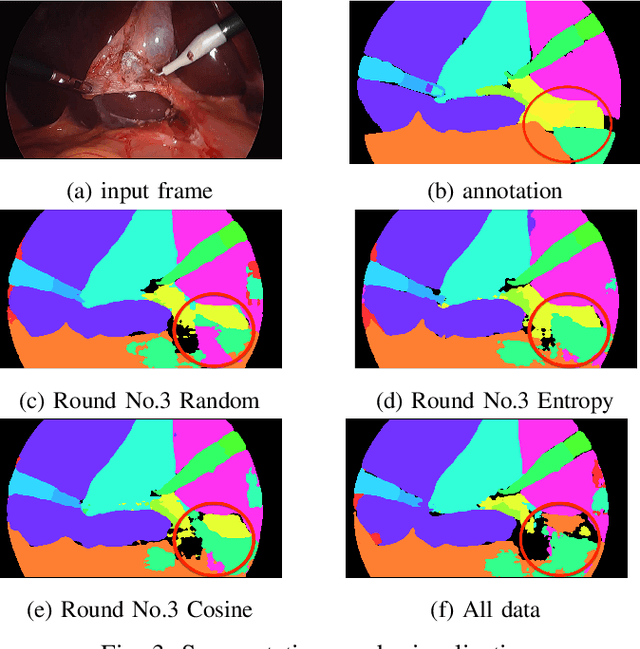
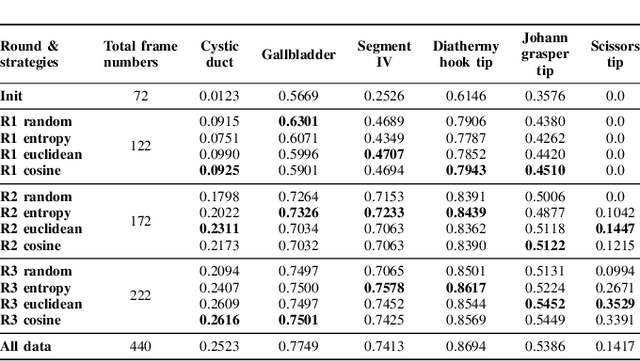
Abstract:Labeling has always been expensive in the medical context, which has hindered related deep learning application. Our work introduces active learning in surgical video frame selection to construct a high-quality, affordable Laparoscopic Cholecystectomy dataset for semantic segmentation. Active learning allows the Deep Neural Networks (DNNs) learning pipeline to include the dataset construction workflow, which means DNNs trained by existing dataset will identify the most informative data from the newly collected data. At the same time, DNNs' performance and generalization ability improve over time when the newly selected and annotated data are included in the training data. We assessed different data informativeness measurements and found the deep features distances select the most informative data in this task. Our experiments show that with half of the data selected by active learning, the DNNs achieve almost the same performance with 0.4349 mean Intersection over Union (mIoU) compared to the same DNNs trained on the full dataset (0.4374 mIoU) on the critical anatomies and surgical instruments.
Detecting Backdoor Samples in Contrastive Language Image Pretraining
Feb 03, 2025Abstract:Contrastive language-image pretraining (CLIP) has been found to be vulnerable to poisoning backdoor attacks where the adversary can achieve an almost perfect attack success rate on CLIP models by poisoning only 0.01\% of the training dataset. This raises security concerns on the current practice of pretraining large-scale models on unscrutinized web data using CLIP. In this work, we analyze the representations of backdoor-poisoned samples learned by CLIP models and find that they exhibit unique characteristics in their local subspace, i.e., their local neighborhoods are far more sparse than that of clean samples. Based on this finding, we conduct a systematic study on detecting CLIP backdoor attacks and show that these attacks can be easily and efficiently detected by traditional density ratio-based local outlier detectors, whereas existing backdoor sample detection methods fail. Our experiments also reveal that an unintentional backdoor already exists in the original CC3M dataset and has been trained into a popular open-source model released by OpenCLIP. Based on our detector, one can clean up a million-scale web dataset (e.g., CC3M) efficiently within 15 minutes using 4 Nvidia A100 GPUs. The code is publicly available in our \href{https://github.com/HanxunH/Detect-CLIP-Backdoor-Samples}{GitHub repository}.
Part-aware Unified Representation of Language and Skeleton for Zero-shot Action Recognition
Jun 19, 2024Abstract:While remarkable progress has been made on supervised skeleton-based action recognition, the challenge of zero-shot recognition remains relatively unexplored. In this paper, we argue that relying solely on aligning label-level semantics and global skeleton features is insufficient to effectively transfer locally consistent visual knowledge from seen to unseen classes. To address this limitation, we introduce Part-aware Unified Representation between Language and Skeleton (PURLS) to explore visual-semantic alignment at both local and global scales. PURLS introduces a new prompting module and a novel partitioning module to generate aligned textual and visual representations across different levels. The former leverages a pre-trained GPT-3 to infer refined descriptions of the global and local (body-part-based and temporal-interval-based) movements from the original action labels. The latter employs an adaptive sampling strategy to group visual features from all body joint movements that are semantically relevant to a given description. Our approach is evaluated on various skeleton/language backbones and three large-scale datasets, i.e., NTU-RGB+D 60, NTU-RGB+D 120, and a newly curated dataset Kinetics-skeleton 200. The results showcase the universality and superior performance of PURLS, surpassing prior skeleton-based solutions and standard baselines from other domains. The source codes can be accessed at https://github.com/azzh1/PURLS.
Visual-Text Cross Alignment: Refining the Similarity Score in Vision-Language Models
Jun 05, 2024Abstract:It has recently been discovered that using a pre-trained vision-language model (VLM), e.g., CLIP, to align a whole query image with several finer text descriptions generated by a large language model can significantly enhance zero-shot performance. However, in this paper, we empirically find that the finer descriptions tend to align more effectively with local areas of the query image rather than the whole image, and then we theoretically validate this finding. Thus, we present a method called weighted visual-text cross alignment (WCA). This method begins with a localized visual prompting technique, designed to identify local visual areas within the query image. The local visual areas are then cross-aligned with the finer descriptions by creating a similarity matrix using the pre-trained VLM. To determine how well a query image aligns with each category, we develop a score function based on the weighted similarities in this matrix. Extensive experiments demonstrate that our method significantly improves zero-shot performance across various datasets, achieving results that are even comparable to few-shot learning methods.
Stochastic Diffusion: A Diffusion Probabilistic Model for Stochastic Time Series Forecasting
Jun 05, 2024Abstract:Recent innovations in diffusion probabilistic models have paved the way for significant progress in image, text and audio generation, leading to their applications in generative time series forecasting. However, leveraging such abilities to model highly stochastic time series data remains a challenge. In this paper, we propose a novel Stochastic Diffusion (StochDiff) model which learns data-driven prior knowledge at each time step by utilizing the representational power of the stochastic latent spaces to model the variability of the multivariate time series data. The learnt prior knowledge helps the model to capture complex temporal dynamics and the inherent uncertainty of the data. This improves its ability to model highly stochastic time series data. Through extensive experiments on real-world datasets, we demonstrate the effectiveness of our proposed model on stochastic time series forecasting. Additionally, we showcase an application of our model for real-world surgical guidance, highlighting its potential to benefit the medical community.
DDA: Dimensionality Driven Augmentation Search for Contrastive Learning in Laparoscopic Surgery
Jun 03, 2024Abstract:Self-supervised learning (SSL) has potential for effective representation learning in medical imaging, but the choice of data augmentation is critical and domain-specific. It remains uncertain if general augmentation policies suit surgical applications. In this work, we automate the search for suitable augmentation policies through a new method called Dimensionality Driven Augmentation Search (DDA). DDA leverages the local dimensionality of deep representations as a proxy target, and differentiably searches for suitable data augmentation policies in contrastive learning. We demonstrate the effectiveness and efficiency of DDA in navigating a large search space and successfully identifying an appropriate data augmentation policy for laparoscopic surgery. We systematically evaluate DDA across three laparoscopic image classification and segmentation tasks, where it significantly improves over existing baselines. Furthermore, DDA's optimised set of augmentations provides insight into domain-specific dependencies when applying contrastive learning in medical applications. For example, while hue is an effective augmentation for natural images, it is not advantageous for laparoscopic images.
Bidirectional Adversarial Autoencoders for the design of Plasmonic Metasurfaces
May 07, 2024



Abstract:Deep Learning has been a critical part of designing inverse design methods that are computationally efficient and accurate. An example of this is the design of photonic metasurfaces by using their photoluminescent spectrum as the input data to predict their topology. One fundamental challenge of these systems is their ability to represent nonlinear relationships between sets of data that have different dimensionalities. Existing design methods often implement a conditional Generative Adversarial Network in order to solve this problem, but in many cases the solution is unable to generate structures that provide multiple peaks when validated. It is demonstrated that in response to the target spectrum, the Bidirectional Adversarial Autoencoder is able to generate structures that provide multiple peaks on several occasions. As a result the proposed model represents an important advance towards the generation of nonlinear photonic metasurfaces that can be used in advanced metasurface design.
Mitigating Challenges of the Space Environment for Onboard Artificial Intelligence: Design Overview of the Imaging Payload on SpIRIT
Apr 12, 2024



Abstract:Artificial intelligence (AI) and autonomous edge computing in space are emerging areas of interest to augment capabilities of nanosatellites, where modern sensors generate orders of magnitude more data than can typically be transmitted to mission control. Here, we present the hardware and software design of an onboard AI subsystem hosted on SpIRIT. The system is optimised for on-board computer vision experiments based on visible light and long wave infrared cameras. This paper highlights the key design choices made to maximise the robustness of the system in harsh space conditions, and their motivation relative to key mission requirements, such as limited compute resources, resilience to cosmic radiation, extreme temperature variations, distribution shifts, and very low transmission bandwidths. The payload, called Loris, consists of six visible light cameras, three infrared cameras, a camera control board and a Graphics Processing Unit (GPU) system-on-module. Loris enables the execution of AI models with on-orbit fine-tuning as well as a next-generation image compression algorithm, including progressive coding. This innovative approach not only enhances the data processing capabilities of nanosatellites but also lays the groundwork for broader applications to remote sensing from space.
 Add to Chrome
Add to Chrome Add to Firefox
Add to Firefox Add to Edge
Add to Edge